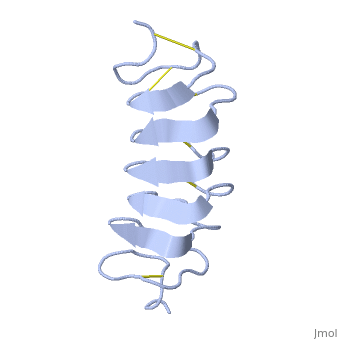1l1i
From Proteopedia
Solution Structure of the Tenebrio molitor Antifreeze Protein
Structural highlights
FunctionANPY1_TENMO Contributes to protect body fluid from freezing at subzero temperatures. Lowers the freezing point of the hemolymph by about 2.5 degrees at a concentration of 1 mg/ml. Binds to nascent ice crystals and prevents further growth.[1] [2] [3] Evolutionary ConservationCheck, as determined by ConSurfDB. You may read the explanation of the method and the full data available from ConSurf. Publication Abstract from PubMedAntifreeze proteins (AFPs) protect many types of organisms from damage caused by freezing. They do this by binding to the ice surface, which causes inhibition of ice crystal growth. However, the molecular mechanism of ice binding leading to growth inhibition is not well understood. In this paper, we present the solution structure and backbone NMR relaxation data of the antifreeze protein from the yellow mealworm beetle Tenebrio molitor (TmAFP) to study the dynamics in the context of structure. The full (15)N relaxation analysis was completed at two magnetic field strengths, 500 and 600 MHz, as well as at two temperatures, 30 and 5 degrees C, to measure the dynamic changes that occur in the protein backbone at different temperatures. TmAFP is a small, highly disulfide-bonded, right-handed parallel beta-helix consisting of seven tandemly repeated 12-amino acid loops. The backbone relaxation data displays a periodic pattern, which reflects both the 12-amino acid structural repeat and the highly anisotropic nature of the protein. Analysis of the (15)N relaxation parameters shows that TmAFP is a well-defined, rigid structure, and the extracted parameters show that there is similar restricted internal mobility throughout the protein backbone at both temperatures studied. We conclude that the hydrophobic, rigid binding site may reduce the entropic penalty for the binding of the protein to ice. The beta-helical fold of the protein provides this rigidity, as it does not appear to be a consequence of cooling toward a physiologically relevant temperature. Structure and dynamics of a beta-helical antifreeze protein.,Daley ME, Spyracopoulos L, Jia Z, Davies PL, Sykes BD Biochemistry. 2002 Apr 30;41(17):5515-25. PMID:11969412[4] From MEDLINE®/PubMed®, a database of the U.S. National Library of Medicine. See AlsoReferences
| ||||||||||||||||||


